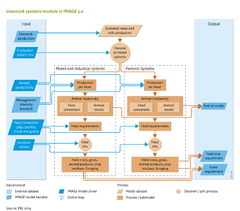Livestock systems/Description: Difference between revisions
Jump to navigation
Jump to search
No edit summary |
No edit summary |
||
| Line 9: | Line 9: | ||
For production characteristics of milk production per cow, off-take rate, and carcass weight, historical data are obtained from statistics; for future years, their values depend on the scenario considered. | For production characteristics of milk production per cow, off-take rate, and carcass weight, historical data are obtained from statistics; for future years, their values depend on the scenario considered. | ||
The next step involves the calculation of energy requirements. Energy requirements of dairy cattle are calculated for the energy needed for maintenance (based on body weight), feeding (based on the fraction of grass in feed rations), lactation (based on milk production per cow) and pregnancy (based on the number of calves per year). The amount of dry matter feed is calculated based on the fraction of digestible energy in total energy and the energy content of biomass. | The next step involves the calculation of energy requirements. Energy requirements of dairy cattle are calculated for the energy needed for maintenance (based on body weight), feeding (based on the fraction of grass in feed rations), lactation (based on milk production per cow) and pregnancy (based on the number of calves per year). The amount of dry matter feed is calculated based on the fraction of digestible energy in total energy and the energy content of biomass. | ||
For cattle, feed requirements are based on animal activity and production, whereas for pigs, poultry, sheep and goats, feed requirements are based on Feed Conversion Ratios ([[FCR]]). FCR is the amount of feed (kg dry matter) required to produce one kilogram of milk or meat. For FCR values, historical data are provided up to the present; for future years, FCR values depend on the scenario selected. | For cattle, feed requirements are based on animal activity and production, whereas for pigs, poultry, sheep and goats, feed requirements are based on Feed Conversion Ratios ([[HasAcronym::FCR]]). FCR is the amount of feed (kg dry matter) required to produce one kilogram of milk or meat. For FCR values, historical data are provided up to the present; for future years, FCR values depend on the scenario selected. | ||
For the calculation of the required areas of cropland and grassland ([[Land use systems or land use allocation]]) are calculated on the basis of feed crop and grass requirements. These in turn are calculated from total feed requirement and diet composition (feed rations). IMAGE distinguishes five feed categories: | For the calculation of the required areas of cropland and grassland ([[Land use systems or land use allocation]]) are calculated on the basis of feed crop and grass requirements. These in turn are calculated from total feed requirement and diet composition (feed rations). IMAGE distinguishes five feed categories: | ||
# grass, including hay and grass silage; | # grass, including hay and grass silage; | ||
Revision as of 10:51, 16 December 2013
Parts of Livestock systems/Description
| Component is implemented in: |
| Components: |
| Related IMAGE components |
| Projects/Applications |
|
| Models/Databases |
| Key publications |
| References |
